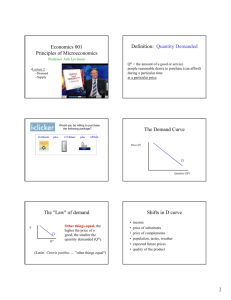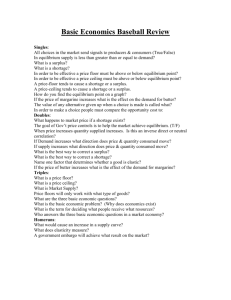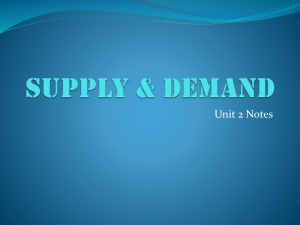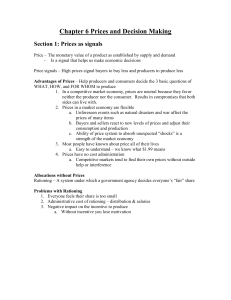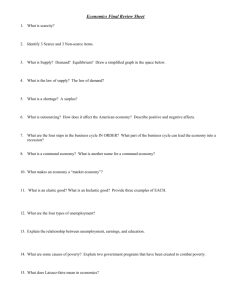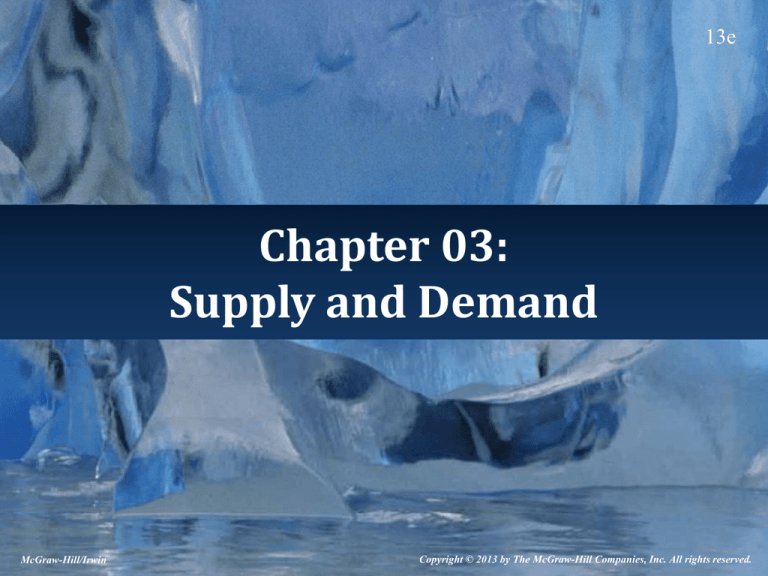
13e
Chapter 03:
Supply and Demand
McGraw-Hill/Irwin
Copyright © 2013 by The McGraw-Hill Companies, Inc. All rights reserved.
Supply and Demand
• The goal of this chapter is to explain how
supply and demand really work.
– What determines the price of a good or service?
– How does the price of a product affect its
production and consumption?
– Why do prices and production levels often
change?
3-2
Learning Objectives
• 03-01. Know the nature and determinants of
market demand.
• 03-02. Know the nature and determinants of
market supply.
• 03-03. Know how market prices are
established.
• 03-04. Know what causes market prices to
change.
• 03-05. Know how government price controls
affect market outcomes.
3-3
Market Participants
• All participants, for the most part, are trying to
obtain the maximum return from the scarce
resources they have.
– Consumers: maximize the utility (satisfaction of unmet
wants) they can get from available incomes.
– Businesses: maximize profits by selling goods that satisfy
while keeping costs low.
– Government: maximize the general welfare of society.
• These motives explain most market activity.
3-4
Specialization and Trade
• Most of us cannot produce everything we
want to consume.
– Time, talent, and resource constraints.
• We should specialize and produce what we
can at a lower opportunity cost than others.
• Produce more than we need for ourselves
and ...
– … trade the excess for the goods we want to
consume (which are produced by other
specialists).
3-5
The Circular Flow
• There are two markets and four
participants:
• Consumers:
– They are owners of factors of production (e.g.,
labor) who supply them to business firms in the
factor market and earn income.
– They purchase goods and services in the
product market.
3-6
The Circular Flow
• Business firms: they produce goods and services
for the product market using the factors of
production they bought from their owners in the
factor market.
• Governments: they acquire resources in the
factor market and provide services to both
consumers and firms.
• International participants: they supply imports
and purchase exports in the product market and
buy and sell resources in the factor market.
3-7
Locating Markets
• A market exists wherever an exchange
(transaction) takes place.
• Every market transaction involves an
exchange of dollars for goods and service (in
product markets) or resources (in factor
markets).
– In the circular flow, goods and services or
resources flow one way, and dollars flow the
opposite way.
3-8
Supply and Demand
• Supply: the ability and willingness to sell
specific quantities of a good at alternative
prices in a given time period, ceteris paribus.
• Demand: the ability and willingness to buy
specific quantities of a good at alternative
prices in a given time period, ceteris paribus.
• Ceteris paribus: the assumption that
nothing else is changing.
3-9
The Law of Demand
• Law of demand: the quantity demanded of
a good in a given time period increases as its
price falls, ceteris paribus (and vice versa).
• Inverse relationship between price (P) and
quantity demanded (Qd).
• A downward-sloping curve on a market
diagram.
3-10
Individual Demand and Market Demand
• Each of us has a demand for a good or a
service if we are willing and able to pay for it.
• The amount we buy depends on its price.
– If the price goes up, we buy less.
– If the price goes down, we buy more.
• Market demand is the collective summation of
all buyers’ individual demands.
3-11
Factors That Set Demand Behavior
(Determinants of Demand)
•
•
•
•
Tastes.
Income.
Expectations.
Other goods:
– Substitutes.
– Complements.
• Number of buyers.
• If any of these factors
change, demand behavior
changes.
• A demand behavior change
is shown by shifting the
demand curve.
– Increase in demand: shift
the curve right.
– Decrease in demand: shift
the curve left.
3-12
Changing Demand
(Shifting the Demand Curve)
• Demand increases (shifts right) when
–
–
–
–
–
–
Taste for the good increases.
Income increases.
Price of a substitute rises.
Price of a complement falls.
Future prices are expected to rise.
Number of buyers increases.
• Vice versa, and demand decreases (shifts left).
3-13
Movements vs. Shifts
• Change in quantity demanded:
movement along a demand curve in
response to a change in price.
• Change in demand: a shift of the demand
curve due to a change in one or more of the
determinants of demand.
3-14
Law of Supply
• Law of supply: the quantity of a good
supplied in a given time period increases as
its price increases, ceteris paribus, and vice
versa.
• Direct relationship between price (P) and
quantity supplied (Qs).
• It is an upward-sloping curve on a market
diagram.
3-15
Factors that Set Supply Behavior
(Determinants of Supply)
•
•
•
•
•
•
Technology
Factor costs.
Taxes and subsidies.
Expectations.
Other goods.
Number of sellers.
• If any of these factors
change, supply behavior
changes.
• This type of change is
shown by shifting the
supply curve.
– Increase in supply: shift the
curve right.
– Decrease in supply: shift the
curve left.
3-16
Changing Supply
(Shifting the Supply Curve)
• Supply increases (shifts right) when
–
–
–
–
–
–
New technology lowers operating costs.
Factor costs decrease.
Taxes decrease or subsidies increase.
Future prices are expected to rise.
Price of alternative goods fall.
Number of sellers increases.
• Vice versa, and supply decreases (shifts left).
3-17
Movements vs. Shifts
• Change in quantity supplied: movement
along the supply curve due to a change in
price.
• Change in supply: a shift in the supply
curve due to one or more changes in the
determinants of supply.
3-18
Individual Supply and Market Supply
• Each producer is willing and able to produce
a good or service if he or she can make a
profit.
• The amount produced depends on its price.
– If the price goes up, more will be produced.
– If the price goes down, less will be produced.
• Market supply is the collective summation
of all producers’ individual supplies.
3-19
Putting a Market Together
• The interaction of buyers
and sellers makes a
market.
• Equilibrium: only one
price and quantity
combination is compatible
with the intentions of both
buyers and sellers.
• Equilibrium is located
where the demand curve
and supply curve intersect.
P
S
Pe
D
Qe
Q
3-20
Equilibrium
•
•
•
•
No shortage exists.
No surplus exists.
Qd = Qs = Qe.
The price will not change
until there is a shift in
demand or in supply.
P
S
Pe
D
Qe
Q
3-21
Equilibrium
• Markets reach equilibrium because buyers have a demand
behavior (raise price, buy less, and vice versa) and sellers
have a supply behavior (raise price, supply more, and vice
versa).
– No one is in charge!
– The market mechanism (Adam Smith’s “invisible hand”) leads
the market to equilibrium.
• At equilibrium, quantity demanded (Qd) equals quantity
supplied (Qs) at the equilibrium price (Pe).
– We say that the market mechanism signals the desired outcome
at Pe.
3-22
Resolving a Market Surplus
• Market surplus: the amount
by which quantity supplied
(Qs) exceeds quantity
demanded (Qd) at a given
price; excess supply.
• Price is too high.
• Qs > Qd, a surplus.
• Buyer and seller behaviors
kick in.
• Price will fall to equilibrium
price, Pe.
P
S
Surplus
Phigh
Pe
D
Qd
Qe
Qs
Q
3-23
Resolving a Market Shortage
• Market shortage: the
amount by which quantity
demanded (Qd) exceeds
quantity supplied (Qs) at a
given price; excess demand.
• Price is too low.
• Qs < Qd, a shortage.
• Buyer and seller behaviors
kick in.
• Price will rise to equilibrium
price, Pe.
P
S
Pe
Plow
Shortage
Qs
Qe
D
Qd
Q
3-24
What Causes the Price to Change?
• Price changes when equilibrium is upset.
– … due to a shift in demand (a change in buyers’
behavior), or …
– … due to a shift in supply (a change in sellers’
behavior).
• After the shift, a surplus or a shortage is
created, and the market mechanism goes
into effect to find the new equilibrium.
3-25
Demand Increases
• Buyers’ behavior changes.
– Demand shifts right.
• Old equilibrium is upset.
• Creates a shortage.
– Price rises.
• A new equilibrium is
established.
• Price rises from P1 to P2.
• Quantity rises from Q1 to Q2.
P
S
P2
P1
Shortage
D2
D1
Q1 Q2
Q
3-26
Demand Decreases
• Buyers’ behavior changes.
– Demand shifts left.
• Old equilibrium is upset.
• Creates a surplus.
– Price falls.
• A new equilibrium is
established.
• Price falls from P1 to P2.
• Quantity falls from Q1 to Q2
P
S
Surplus
P1
P2
D2
Q2 Q1
D1
Q
3-27
Supply Increases
• Sellers’ behavior changes.
– Supply shifts right.
• Old equilibrium is upset.
• Creates a surplus.
– Price falls.
• A new equilibrium is
established.
• Price falls from P1to P2.
• Quantity rises from Q1 to Q2.
P
S1
Surplus
S2
P1
P2
D
Q1 Q2
Q
3-28
Supply Decreases
• Sellers’ behavior changes.
– Supply shifts left.
• Old equilibrium is upset.
• Creates a shortage.
– Price rises.
• A new equilibrium is
established.
• Price rises from P1to P2.
• Quantity falls from Q1 to Q2.
S2
P
S1
P2
P1
Shortage
D
Q2 Q1
Q
3-29
Summary: When Do Prices Change?
• Only when a market is in disequilibrium.
– Shortage? Price rises.
– Surplus? Price falls.
• A shift in either demand or supply causes
the price to change, BUT….
• A price change does NOT cause
– … the demand curve to shift or
– … the supply curve to shift.
3-30
Market Outcomes
• The market mechanism affects WHAT, HOW,
and FOR WHOM to produce.
– WHAT? Markets determine which goods are
desired and which are profitable.
– HOW? Profit-seeking producers will strive to
produce goods in the most efficient way.
– FOR WHOM? To obtain a good, one must be
both willing and able to purchase it.
3-31
Price Controls
• Governments may impose an arbitrary
maximum price (price ceiling) or a
minimum price (price floor) on a market.
– The result is that the market cannot reach
equilibrium.
3-32
Price Ceiling
• Government imposes a
maximum price less than
Pe.
• This generates a shortage
(Qd > Qs).
• The market mechanism
cannot clear the market.
• A permanent shortage
exists.
P
S
Shortage
Pe
Price
ceiling
D
Qs
Qe
Qd
Q
3-33
Price Floor
• Government imposes a
minimum price greater
than Pe.
• This generates a surplus
(Qs > Qd).
• The market mechanism
cannot clear the market.
• A permanent surplus
exists.
P
S
Surplus
Price
floor
Pe
D
Qd
Qe
Qs
Q
3-34




